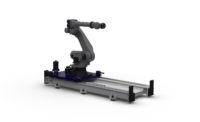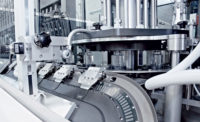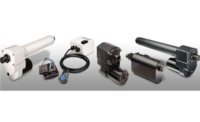Automation
Avoiding Common Pitfalls When Selecting & Integrating Linear Modules
Seven tips to help avoid common technical and operational issues.








Fully integrated linear modules can be versatile and cost-effective for linear transport applications in packaging machinery. When specifying and integrating pre-engineered linear modules, whether for Cartesian robots, pick-and-place equipment or linear transport systems in or between production lines, following these seven key tips can help avoid common technical and operational pitfalls.
1) Size correctly for long-term use.
The most common mistake is sizing linear modules improperly for long-term use. Too often, purchasers will determine the standard speed or load capacity of the system they are building and then select a module whose maximum speed or load is that same number. This leads to under-sizing the module, which can result in multiple possibilities for failure. In addition, if the linear module is under-sized for the load its carrying, this may void a manufacturer’s warranty.
An opposite mistake is oversizing — selecting a module with much more carrying or speed capacity than an application requires. While this can be safer, it’s more costly than what’s actually needed. Work with a supplier that can provide high quality, easy-to-use sizing software to ensure the linear module is sized precisely for the application.
2) Avoid over-specifying performance criteria.
Searching for and selecting linear modules based on overly precise performance criteria can lead to linear modules that are more expensive and complex to work with than necessary. For example, some linear modules are available in both steel and aluminum extrusion housings for the guide into the drive system. The steel housing is much more rigid but also has higher costs. Depending on the load to be carried by the module, aluminum housing may be a better solution.
The two most widely used mechanical drives in linear modules are belt drives and ball screw drives. Ball screw drives work best for applications that require a high degree of end-point accuracy and repeatability, as well as carrying or moving loads vertically.
If the packaging machine’s linear motion requirements do not require high end-point accuracy, belt-driven linear modules can provide a more cost-effective and fully functional solution. For example, the Bosch Rexroth MKR Belt Driven Module features a high-performance, toothed belt for high drive torques, long travel lengths and high rigidity. This type of linear module is available in multiple lengths and has an end-point accuracy of 500 microns, which can satisfy many applications.
3) Consider linear module mounting and integration into larger machines.
Linear modules are often integrated into larger machines or combined into systems such as pick-and-place Cartesian robots. One item often overlooked is the module connection and mounting. Depending on the supplier, some modules are designed to be mounted only by the base of the extrusion; if the mounting location on the machine doesn’t allow for that, additional mounting brackets and other hardware may have to be purchased or machined from scratch, increasing costs and adding time to machine integration.
Be sure to investigate how a linear module will be mounted and evaluate mounting options. In addition, check if features are included to help fit and align modules quickly and accurately into tight machine spaces. Standardized, positive-locking connection elements with centering technology alleviate the need for expensive, custom-designed construction. Bosch Rexroth linear module components, for example, feature connecting elements, such as brackets, adapter plates, clamping fixtures, sliding blocks, T-nuts, positive-locking centering rings, etc., designed to simplify installation and integration.
4) Make sure CAD models are included in the package.
Some linear module suppliers don’t include complete CAD models as part of the purchase. While that may lower the initial cost, it’s usually necessary to create CAD models anyway in order to properly engineer, configure and integrate the final system. If a CAD model isn’t included, the OEM or end-user will need to create their own. However, many companies are scaling back engineering departments to control costs, so this additional task can end up slowing down the project. While many linear module manufacturers include CAD models as standard elements, it pays to be certain.
5) Use linear modules that have been fully tested to ensure proper mounting and alignment.
Incorrect mounting and alignment practices can degrade linear module performance, with components like bearings and belt drives wearing out faster than expected. Work with a linear module supplier whose products are engineered with centering technology, such as centering holes and slots for connectivity, which helps to ensure that all components are tightly aligned and level as part of the installation process.
It’s also important to ask about the type of performance testing a linear supplier conducts on its products. Some suppliers assemble and deliver customers’ modules without testing first, leading to specification issues after the install. It’s best to work with a supplier that performs a runoff test with torque measurement, verifying that when the linear module is manufactured, it meets all specifications.
6) Check the linear module design for easy lubrication access points.
Linear modules require regular lubrication. A common pitfall is that linear modules are often installed in packaging machinery where lubrication ports are hard to access. A linear module design should feature multiple lubrication ports, making it easier to integrate into the machine design.
It’s also extremely important to follow the manufacturer’s guidelines for lubrication. This is typically a very specific type of lubricant — for example, for linear ball bearings, an NLGI lithium soap grease with no solid particles must be used. Many users apply lubricant with carbonate or other solid particles because they can use it in other parts of the machine. Unfortunately, this can cause wear and premature failure for linear module bearings.
7) Align the linear module performance characteristics with the motion controller.
Finally, when integrating linear modules on a machine, the motion controller and drive parameters must be programmed with correct, safe torque limits and end-of-stroke limits to ensure the linear module doesn’t overshoot its limits or operate with excessive end-point vibration. It’s best to confirm the electrical and mechanical engineers on a project clearly understand the established parameters for each linear module.
Looking for a reprint of this article?
From high-res PDFs to custom plaques, order your copy today!










